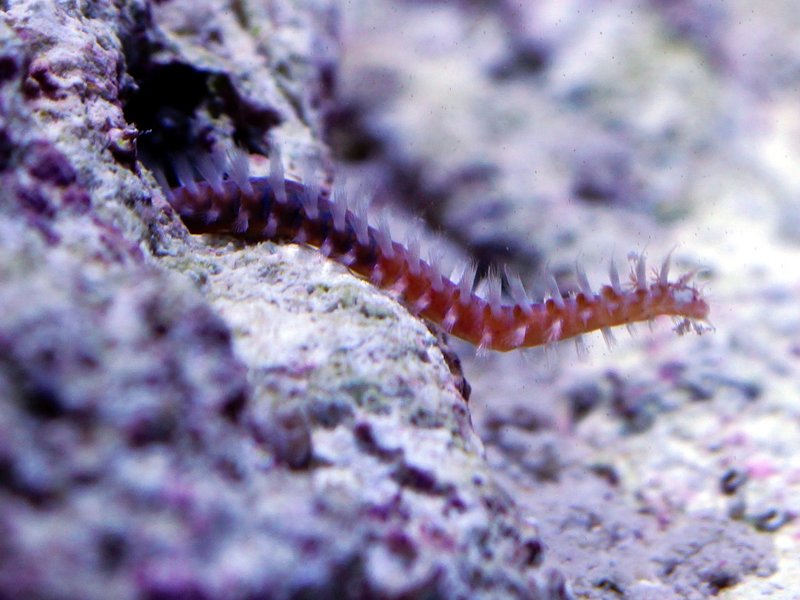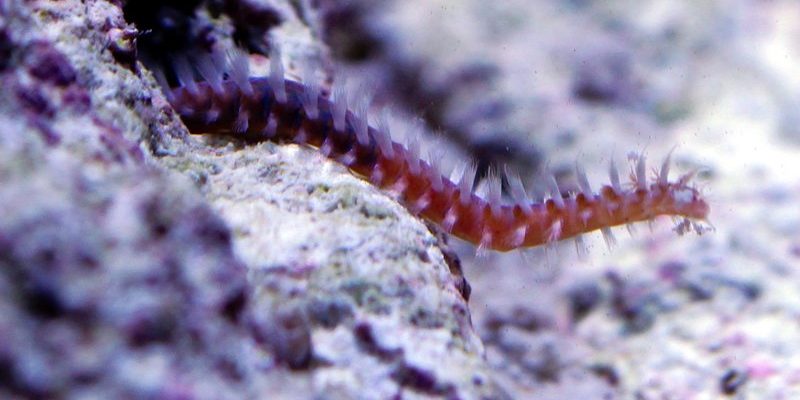
These creatures belong to a broader family of worms known as polychaetes, and they can be both good and bad for your aquarium ecosystem. But how exactly do they invade your setup? Spoiler alert: it’s usually through the rock, sand, or even freshwater sources you introduce into your aquarium. In this article, let’s dive into the world of bristle worms, uncover how they end up in your tank, and what you can do about it.
What Exactly Are Bristle Worms?
Bristle worms are segmented worms, and they can range in color from reddish-brown to pale white. They have bristles, or chaetae, along their bodies, which can be a bit prickly if you touch them. Imagine their bristles as nature’s way of giving them armor. These little guys are typically found in benthic environments, meaning they live in the sand and mud of ocean floors.
In saltwater aquariums, they can play a positive role by breaking down organic matter and contributing to the biological filtration. You might think of them as little cleaners of the sea. However, **overpopulation** can lead to problems as they can consume beneficial corals or compete for food with other inhabitants.
So, while they can be helpful to a point, you wouldn’t want your aquarium overrun by these critters. A few here and there can benefit your ecosystem, but a bristle worm infestation can spell trouble.
How Do Bristle Worms Get Into Your Aquarium?
You might be surprised to learn that bristle worms can hitch a ride into your tank in several ways. Here are the most common culprits:
- Live Rock: When you introduce live rock into your aquarium, you’re not just adding a home for coral and fish; you may also be bringing in unwanted hitchhikers, including bristle worms.
- Sand Substrates: If you purchase aquarium sand or gravel, it might also contain tiny eggs or juvenile worms that can grow once introduced into your tank.
- Water Changes: If you’re using water from another aquarium or a questionable source, there’s a chance that bristle worm larvae could come along for the ride.
Honestly, the best way to prevent an invasion is by carefully sourcing your aquarium materials. Always choose reputable suppliers and check for signs of live pests when you’re shopping.
The Role of Bristle Worms in Your Aquarium Ecosystem
Now that we know how bristle worms get into aquariums, it’s worth discussing their roles. They are scavengers at heart, feeding on detritus, uneaten food, and dead organisms. This makes them essential for keeping your aquarium clean. You might think of them like the clean-up crew of the ocean floor—without them, waste could pile up and disrupt the tank’s balance.
But here’s the catch: too many bristle worms can become detrimental. As they reproduce quickly, they can outcompete other beneficial organisms for food, leading to a decline in your tank’s biodiversity. A few bristle worms might keep the ecosystem in check, but an overabundance can lead to **detrimental effects** on corals and delicate marine life.
Understanding their dual role helps you maintain a balanced ecosystem in your aquarium. It’s crucial to keep populations in check for optimal marine health.
Signs of Bristle Worm Infestation
How can you tell if your aquarium has become a bristle worm haven? Here are some common signs to look out for:
- Increased Visibility: You may notice more of these worms wriggling about, especially at night when they come out to feed.
- Coral Damage: If your corals look like they’re being nibbled on, it could be the work of hungry bristle worms.
- Uneaten Food: If you see food accumulating at the bottom of your tank, that might indicate other tank inhabitants aren’t getting their fill because the bristle worms are hogging it.
If you notice these signs, it might be a good idea to take action before the problem escalates.
Managing Bristle Worm Populations
If you find yourself dealing with too many bristle worms, don’t panic! There are several strategies to manage their populations:
- Manual Removal: You can use tweezers to carefully pull them out during tank maintenance. Be sure to wear gloves to avoid their bristles!
- Control Feeding: Scale back on feeding and try to reduce uneaten food that can fuel their growth.
- Introduce Predators: Some fish, like certain types of wrasses, will eat bristle worms. Adding appropriate tank mates can help keep their numbers in check.
Here’s the thing: finding the right balance is critical. Not all bristle worms are bad; it’s about managing their populations so that they can be part of your ecosystem without taking over.
Preventing Future Invasions
If you want to dodge the bristle worm bullet in the future, consider these preventative measures:
- Quarantine New Additions: Always quarantine live rock, sand, and marine animals before introducing them into your main tank.
- Source Wisely: Buy materials from trusted suppliers who actively check for unwanted pests.
- Regular Maintenance: Keep your tank clean and regularly check for any abnormal growth of these worms.
Taking a proactive approach now can save you a lot of hassle later.
Bristle worms can be a bit of a mixed bag in the world of saltwater aquariums. They’re like that friend who is fun and helpful but can also be a little too much sometimes. Understanding how they invade your aquarium, their roles, and how to manage their populations can help you maintain a thriving, balanced ecosystem.
So, the next time you spot a bristle worm wiggling in your tank, don’t react in fear. Take a moment to assess the situation and decide whether they’re helping or causing trouble. With the right information and strategies, you can keep your saltwater aquarium healthy and enjoyable!

